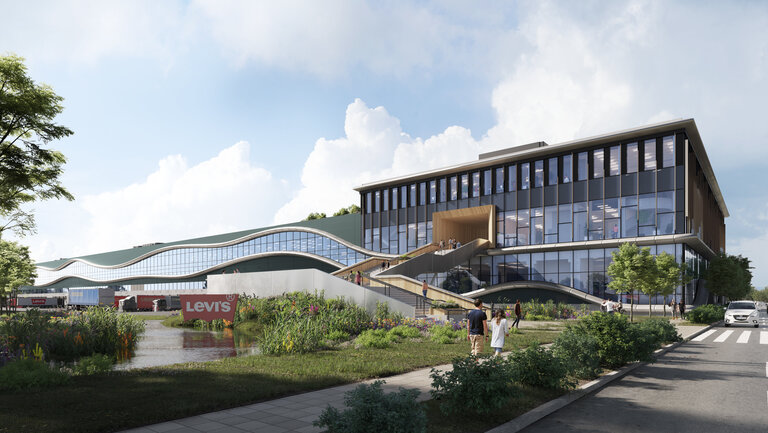While consumers’ minds are on deciding which denims to wear tomorrow morning, global jeanswear market leader Levi Strauss & Co. is already thinking about the day after tomorrow. In the Große Heide Wulfen industrial estate in Dorsten, on the northern fringe of Germany’s Ruhr area, a sustainable logistics hub for the European market is under construction. The main focus of the building company, Delta Development, is on recyclability. This places high demands in terms of the construction, as the building is meant to act as a kind of raw materials depository which, at the end of its useful life, releases its materials for new projects. To assist in meeting this challenge, Delta brought on board a team of experts in recyclable products from Drees & Sommer subsidiary EPEA. After almost 18 months in construction, the 70,000 square-meter-plus new build project is to be handed over to Levi Strauss & Co.
“We intend to make the operation of the logistics building carbon-neutral during the period of the lease. Apart from efficient energy design, our priority is resource conservation,” explains Julian von Hodenberg, senior project manager at Delta Development. The main idea is to ensure that the materials used in the building do not end up in landfill in the event of later alterations or demolition, but can instead be used in new building projects.
“In the face of climate change, resource scarcity, and biodiversity loss, the logistics sector with its extensive use of space has a particular responsibility to do things differently,” says Eric Tepner, who heads the Logistics team at Drees & Sommer. In Dorsten, it paid to make use of the past. The new logistics center is situated on the hitherto vacant site of the disused mine at Wulfen. On the former industrial site there was still a large number of precast concrete units which, in conventional building projects, would first have had to be disposed of. “Instead, we crushed the precast units and used the rubble to compact the soil. In this way, we were able to put the remainders from the open-pit mine to efficient use and follow the principle of circularity even before the actual construction started,” explains Drees & Sommer’s logistics expert. Eric Tepner believes that many more developers in Germany should be making use of vacant sites like this one. As a complement to construction on greenfield sites, brownfield sites have an important role to play in the battle against excessive land consumption and ongoing soil sealing.
Knowing What Is Involved
The choice of building materials was also based on recycling, conserving resources and reducing waste. “Many of the resources used in the building are sustainably sourced and used in a way that enables them to be recycled,” comments Marcel Özer, team leader at EPEA-Part of Drees & Sommer. A Circularity Passport®, which is also set to be introduced in the future by the German federal government, records details of the materials used in the building and their properties. “The passport also contains information on substances, product compositions, the percentage of recycled materials a product contains, and environmental performance evaluation figures. This makes the environmental and material value of a building clearly and easily traceable. It also enables optimum separation of the materials into their constituent parts at the end of the building’s useful life – the materials can then be released for new construction projects,” added the specialist.
Resource management at the new logistics center is not only focused on the construction method. There is also a system for collecting rainwater, storing it in an underground tank and using it to water the roof planting as well as to flush toilets. Also, on-site recycling facilities are being built to minimize day-to-day waste.
Renewable Energy from the Sun and the Earth
For the logistics building to operate sustainably, the energy design is of key importance. The warehouses can be heated and cooled efficiently with the aid of a geothermal heating and cooling system. 100-meter-deep boreholes in the ground enable the use of heat generated within the Earth. Solar panels are also installed on most of the roof surfaces so that the building can produce its own electricity.
At peak times, any surplus electricity produced can be fed into the national grid, and other buildings can also be supplied with climate-friendly electricity. On the areas of the roof not being used to produce solar energy, staff members can go out for a breath fresh air among poppies and cornflowers. The roof garden with its native wildflowers is not only intended to provide room for a multitude of insects; In addition to adding biodiversity, the planting is designed to filter pollutants from the surrounding air and create a pleasant microclimate.
The approximately 650 staff members working at Levi’s are to move into the new logistics center at the end of 2023. By then, parking spaces for bicycles and charging points for electric vehicles will be in place, in line with the sustainable mobility plan. After completion, an application will be made for LEED (Leadership in Energy and Environmental Design) and WELL Platinum certification for the building’s environmentally-friendly construction method. Julian von Hodenberg comments: “With its high standards of recyclability, material health, and energy and resource management, the new building serves as a blueprint for greater sustainability in the entire logistics sector.”
[A1]Richtig verstanden?

